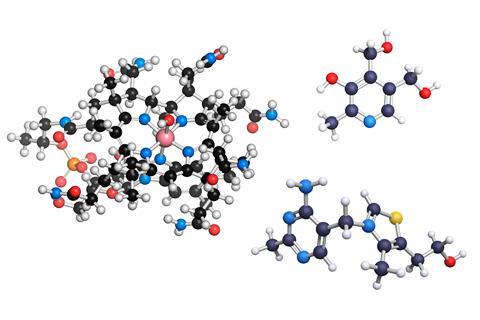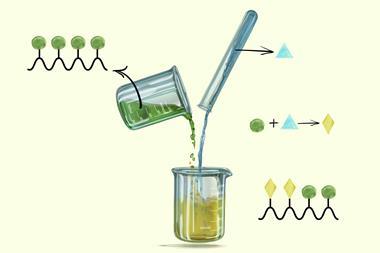The history of vitamins shows that ‘kinds’ don’t have to exist in nature to drive scientific discoveries

New concepts can help to guide scientific research, and even originate entire fields of research. Very simply, introducing new categories invites a search for the underlying mechanisms that realise them. Iteroselectivity is a good example of this. As Roy Lavendomme and Ivan Jabin discussed recently in Chemistry World, they introduced this concept in 2014 to express a special kind of selectivity that governs the number of repeating chemical transformations that occur on a substrate bearing multiple identical functional groups, or that occur when the reactive group is regenerated.
The introduction of iteroselectivity as a category, or ‘kind’, is beneficial as it allows researchers to focus on the specificity of the transformations involved in these processes.1 In particular, it seems that this category might capture a ‘natural kind’ of phenomenon – something that exists independently from how we think of it and improves our knowledge of the chemical world. However, do all the concepts introduced to guide research have this property? Or are some categories ‘conventions’, something we introduce because they play a useful role but do not capture anything that really exists? And should those conventions be introduced anyway?
In my view, introducing new categories can boost research, independently of whether they are real or conventional kinds.2 One great example to illustrate this is the discovery of vitamins. The introduction of the category ‘vitamin’ boosted important results for many sciences from nutrition and medicine to synthetic chemistry, despite the fact that now some of the classifications of vitamins might not track real kinds.
Broadly defined, vitamins are complex chemical compounds that play an essential role in human physiology and are grouped together by virtue of the role they play. Their discovery has been of crucial importance to cure and prevent diseases such as scurvy and beriberi, and we are all familiar with the need to take vitamin D when we are not exposed to much sunlight or vitamin B12 if we are following a plant-based diet. The chemical structures and properties of these vitamins are now well-known. However, although their chemical structures and properties are now well-known, this was not the case when the category ‘vitamin’ was introduced.
The study of vitamins started at the end of the 19th century when physicians studied diseases correlated with poor nutrition. Casimir Funk named the organic molecules that seem to prevent these diseases ‘vitamines’, combining their being essential for life (vital) and presenting an amine group.3 This category was then divided by Elmer McCollum and Marguerite Davis in two broad families: fat-soluble vitamin A, and water-soluble vitamin B.4 The category ‘vitamin’ was introduced before we knew how many vitamins are there, how they work and which precise contribution could be ascribed to them. For instance, we have changed the name from vitamines to vitamins as we now know that not all vitamins present an amine group.
The more we discovered, the more different vitamins were classified and grouped by virtue of some macro-properties: a given function, origin and solubility. This information invited further research. Vitamin C and Vitamin D were added to the groups. Vitamin families expanded too: starting with vitamin B1 (thiamine), researchers added first vitamin B2 (riboflavin) and then others, such as vitamin B6 (pyroxidine) and vitamin B12 (cobalamin).5 It was soon discovered that the vitamin B family displays high heterogeneity: these macromolecules present different chemical structures and biochemical functions, and only share some properties related to solubility and history.
Should we disregard the category vitamin B?
This heterogeneity might indicate the conventionality of the family vitamin B: these molecules are clustered together because of contingent reasons related to their discovery and not independently from us. Should we then disregard the category vitamin B, if it does not correspond to a real kind? The philosophy of science suggestion is no: categories we now might consider conventional are still useful to investigate the world and discover real natural kinds. For example, suggesting the existence of the vitamin B family led to the discovery of vitamin B6 and vitamin B12.
In this regard, the philosophers Ingo Brigandt and Paul Griffiths suggest that some kinds can be considered ‘investigative kinds’, meaning those that have to be clarified through empirical inquiry and can lead to further discoveries. These kinds are open categories, rather than definitive ones. The vitamin families, such as vitamin B, can be considered one of these investigative kinds: they invited investigation and then the discovery of other real kinds. Investigative kinds might lose their utility if the discovered natural kinds are more efficient in guiding and categorising scientific knowledge. But we might maintain them if they are still helpful to organise knowledge or serve other purposes. For instance, the category ‘vitamin B family’ can still be useful for studies in nutrition and dietary prescriptions.
I believe the introduction of new categories is beneficial, even at the risk of introducing conventional ones. The history of chemistry presents various instances of this, such as the category ‘phlogiston’, which led to the investigation of combustion and then the discovery of oxygen. Or kinds such as species or emotions are, according to Brigandt and Griffiths, ‘investigative’: they guide research and discovery.6,7 Thinking about research categories as investigative rather than definitive is precious for chemists as it can allow them to see how new categories can be resources for investigation rather than a finished result. The openness of the investigative kinds allows researchers to maintain contact with the world via investigation, while leaving open the possibility of introducing and discovering other real kinds. Only time will tell us which wonderful things can be discovered once we allow the new categories to play their role, as by the introduction of iteroselectivity.
References
1 M A Khalidi, Natural categories and human kinds: Classification in the Natural and Social Sciences. Cambridge: Cambridge University Press, 2013 (DOI: 10.1017/CBO9780511998553)
2 F Bellazzi (2022), The British Journal for Philosophy of Science, DOI: 10.1086/723241
3 C Funk, The Vitamines. Williams & Wilkins Company, 1922
4 E V McCollum and M Davis, Journal of Biological Chemistry, 1913, 15, 167
5 K Lindblom, The Vitamin B complex. American Chemical Society, 2016
6 I Brigandt, Philosophy of Science, 2003, 70, 1305 (DOI: 10.1086/377409)
7 P E Griffiths, Philosophy of Science, 2004, 71, 901 (DOI: https://doi.org/10.1086/425944)












No comments yet